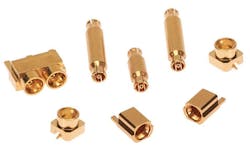What you’ll learn:
- COVID-19 and 5G are creating more opportunities for the connector market.
- How the overall technology trend of “smaller, faster, and lighter” impacts the advancement of connectors.
- The call for customization is overshadowing reliance on off-the-shelf connectors
Whether talking about life in general or RF, microwave, and coaxial technology specifically, the best results come from having good connections. The evidence is clear when it comes to the state of the connector market, which continues to evolve at a rapid pace.
The surge in opportunities is being driven by two main factors: The expected impact of burgeoning 5G rollouts and the unexpected circumstances brought about by COVID-19. The former continues to spark a seemingly endless list of new applications across countless industry segments, while the latter is spurring a massive uptick in work-from-home and remote-learning scenarios.
The common thread connecting these two scenarios is the persistent need for networking and communications, which places greater focus on the connector market. Now more than ever, choosing the proper interconnects for today’s applications is critically important.
Smaller, Faster, and Lighter
Over the past 15 to 20 years, there has been a steady trend toward all devices becoming smaller, faster, and lighter. In response, connectors must be redesigned constantly to address considerations relating to size, performance, and application. While smaller connectors (Fig. 1) typically are better for higher-frequency applications, there are always tradeoffs that manufacturers must overcome.
Because coaxial connectors operate as a separable interface system, applications must decide between mating styles and contact geometries, which stop some of the smaller connectors from being effective beyond 6 GHz. Depending on the type of device and use, the smaller the connector, the larger the losses and attenuation.
Always a top-of-mind concern, attenuation typically is attributed to three factors: resistive and dielectric losses, reflected energy losses, and radiating or leakage along the line because of insufficient shielding. If greater losses occur through the transmission-line structure, higher power is required at the signal source or amplifier, which adds unwanted costs.
These types of dynamics represent a constant struggle for designers, from both the customers’ and manufacturers’ camps. Not making the situation any easier, this also is where COVID-19 comes into play. As the coronavirus has impacted seemingly every aspect of our lives, the connector market continues to respond to greater demand brought on by the seemingly insatiable appetite for more communications bandwidth.
Due to rapid transitions to work-from-home and distance learning, telecommunications service providers globally have been accelerating broadband rollouts while striving to improve connectivity of all types. More connectivity requires more connectors.
5G Gains Momentum
On the hype curve, 5G hasn’t crested yet, so there are many more wireless advances to play out. Many 5G participants still are trying to unearth and understand the best (i.e., most revenue producing) use cases like enhanced mobile broadband. While 4G LTE may be perfectly suitable for the vast number of users in the short term, applications such as connected healthcare, at-a-distance collaboration tools, and autonomous vehicles are poised to propel 5G’s greater bandwidth and lower latency to mass adoption.
New applications will demand new connectivity solutions, which will go beyond the requirements for just another connector. This represents a great opportunity for connector manufacturers to move up the value chain and play a more integral role, as early as the concept and design phases, to drive innovations and technology advances.
Connectors that have been in play since the heyday of rotary-dial telephones won’t meet the new performance demands of service providers and others developing new generations of products. And, in many instances, a connector alone isn’t enough. For instance, an early collaboration to develop a concept for a new multi-position RF board-to-board connector could evolve into a design for an integrated antenna array that delivers superior performance while combating lingering attenuation.
To devise such a solution requires system-engineering-level exploration and collaboration, which has not always been the domain of the connector developer. As the applications and industry advance, though, there will be increased examples of where these new engineering partnerships will produce ground-breaking solutions.
In 5G base-station radios, where attenuation is a critical issue, developing a connector system that could go between the filter module and antenna would have a huge impact. In these radios, the antennas are very narrow in bandwidth, so 600-MHz or 1.9-GHz radios can’t use the same antenna. The same goes for 5G at millimeter-wave (mmWave) frequencies. Here’s where collaborative connector design saves the day in the form of a multi-position RF board-to-board connector (Fig. 2).
Interactions between manufacturers and their customers can go in multiple directions—sometimes with surprising results. Attending to attenuation remains the focus because of splitting the signal into multiple, individual beams, up to 128 beams per cellular radio. As a result, the output power is very low. So, if there’s high attenuation, consumers will not be able to get a good signal or the call may drop altogether. The stakes are upped significantly for potential 5G applications where losing connectivity is unacceptable.
The Call for Customization
As the above example illustrates, a growing demand for customized solutions will transform the connector market. Over time, the market will likely deviate from today’s standard RF connectors to include tailored products ideally suited for a diversified portfolio of applications and use cases.
For example, with industry-standard PCB-mount connectors for automotive applications, there’s a growing need for customized designs. This approach persists even if it means losing some of the benefits of large-scale, off-the-shelf purchasing that could lower costs. Rather, there’s greater focus on balancing cost with the need for slightly different functionality or advanced features that improve performance.
Other needs for customization are born out of necessity. Consider the case when tailoring a solution enables installers to mate to a connector that’s two or three printed circuit boards (PCBs) below where their fingers can reach. While an off-the-shelf version might be able to mate to that PCB connector, it’s physically unable to reach it. Coming up with an innovative design, such as a thumb overmold, is both practical and necessary.
Overall, the big driver for microwave and RF connectors is ease of use. Therefore, manufacturers must be ready and willing to answer the call in situations such as when a broadband provider requests an RF connector with an overmolded, color-coded plastic strain relief.
Manufacturing Adapts to Connector Advances
New applications will drive new solutions while elevating the demand for innovative manufacturing methods. Historically, screw machining has been the predominant method for connector components. Its popularity is due to its proven flexibility, which requires little or no tooling—just set up the machines to “turn down” the material to create the component’s features.
The advantage of screw machining is delivering the tightest tolerances possible, which yields better electrical performance compared to plastic or die-cast molding and stamping. The new capabilities of computer-numeric-control (CNC) turning machines empower complex designs to be machined completely—and with all of the necessary features. While older, cam-driven methods are faster, they require many features, such as holes, slots, and milling, to be attended to on secondary machining cells.
Connectors made of brass, beryllium, copper, stainless steel, and polytetrafluoroethylene (PTFE) remain the most popular choices. Beryllium-copper alloys are favored for female center-contact designs and outer (ground) conductors, because the material can be heat-treated to create spring memory. As with other forms of copper, this alloy provides good electrical conductivity. Its high tensile strength also is a plus as is its long-term memory when heat-treated.
What Lies Ahead
Makers of interconnect technology must close the growing gap between providing customers with standalone components and fully integrated solutions. This challenge is best met by manufacturers getting involved as early as possible during the design and systems engineering phase. The ability to “design in” robust capabilities will move the entire connector industry forward while empowering customers with solutions that fit unique specifications and drive differentiation.
Manufacturers making 5G radios already are in uncharted waters. Relying on traditional connectors and technologies to make antennas for these radios won’t make the process any easier. It’s imperative not to get so caught up in small details that ultimately obscure the end goal. Instead, it’s time to step back and step up. If the call is for different attributions and features, the answer may not be yesterday’s connectors.
This requires a different set of disciplines, especially for design engineers. To see clearly and innovatively regarding technology advances, from connectors to 5G as well as shaping what our world should be like post-COVID, requires thinking outside the box and beyond the standard fare. The answer lies in integrated solutions that solve tough connectivity problems while driving differentiation.
Roger Kauffman is Director of Product Management and Marketing for Molex.


